What is Southwest TURN?
Over the past decade, the Southwest Teacher Union Reform Network has worked to bring together teacher union and school district leaders to study innovative reforms that can lead to increased achievement for all students. Through twice yearly meetings, SW TURN brings together union leaders, administrators, outside experts, and other key stakeholders. Over the past several years, districts participating in SW TURN have represented some of the largest in the region, including Denver, Albuquerque, Las Vegas, Austin, Houston, Omaha and Tulsa. These districts alone serve more than 700,000 students in the region. The organization’s main goal is to support district and teacher union leaders in bringing about positive change that supports teachers and improves student learning and growth.
What are the impacts of SW TURN on participating school districts?
In an effort to answer this question, the Consortium for Education Change (CEC) in 2017 commissioned an independent study of SW TURN impacts on participating school districts. CEC selected Augenblick, Palaich and Associates (APA) to conduct this study. APA is an independent research firm with more than 30 years of experience providing objective evaluation of education policies and practices. In particular, since a key goal of TURN is to create positive change in school and district practice by promoting innovative ideas among union and district leaders, APA’s evaluation focused on the following target: To identify districts that have implemented substantive changes in schools as a direct result of participating in SW TURN.
This target was complicated by two key realities. First, TURN operates primarily by sharing information across district and union leaders through meetings twice a year supplemented by electronic communications and meeting materials. While these meetings are intensive and offer the opportunity over multiple days for participants to delve deeply into particular topics, TURN does not currently have the resources to provide follow-up technical assistance between meetings to the many district and union leaders from eight different states that participate. Second, districts in the SW TURN region operate within widely differing legal and policy environments. For instance, while collective bargaining for teacher unions is allowed in some states in the region, such as Colorado, such bargaining is prohibited in other states, such as Texas. This means that districts in differing jurisdictions may need to develop their own creative mechanisms in order to implement ideas generated through TURN within the realities of their own local contexts.
With these realities in mind, APA worked to identify any districts in the southwest region that directly attributed substantive programmatic changes over the past several years to participation in TURN. Interviews with SW TURN leaders and participating members were conducted, and these indicated a wide array of positive impacts on multiple participating districts. For the purposes of this case study, however, this report seeks to tell the story of The San Antonio Independent School District (SAISD) and the development of its peer assistance and review (PAR) program designed to help support and retain new teachers in high need schools.
Notably, the San Antonio experience represented a collaborative effort between district leaders and the teacher union in a state where collective bargaining is not allowed under state law. Despite this legal context, both teacher union and district leaders directly attribute the successful creation of a new PAR program to participation in SW TURN. After learning about this collaboration, APA decided to conduct a full case study to better understand SW TURN’s role in the development of the PAR program and how the program has impacted the district.
Methodology
APA conducted a site visit to San Antonio in March 2017 to better understand how the district’s PAR program has evolved from discussions and presentations at a SW TURN meeting in 2014 to an actual pilot in the 2016/2017 school year. During this site visit, APA:
- conducted meetings with leaders from the San Antonio Alliance for Teachers and Support Personnel;
- conducted interviews with SAISD leaders;
- ran a focus group that included almost all of the elementary and secondary school principals whose schools are participating in the PAR program, which included a short survey at the conclusion of the focus group;
- ran a focus group that included all current mentor (or consulting) teachers in the district’s PAR program, with an additional short survey;
- conducted focus groups of new teachers at both the elementary and secondary school levels that received consulting teacher support; and
- gathered data from an electronic survey of new teachers from across the district that received consulting teacher support.
Findings from these data gathering activities are reported below.
The Challenge: Supporting New Teachers in a High Need Urban District
The San Antonio Independent School District (SAISD) has a total enrollment of 53,701 students, employs 7,382 people, and serves a student population where 92% of students are considered economically disadvantaged and many are English language learners. Located in downtown San Antonio, the district faces challenges that many other urban districts face across the country. In particular, the district faces a continual challenge with the turnover of new teachers in high need schools.
With regard to teacher retention, district leaders in interviews with APA noted that they face a consistent trend where, after several years of teaching in the district, new teachers gain valuable training, coaching, and experience but then many leave SAISD for teaching jobs in surrounding, more affluent school districts. This turnover represents a continual drain on the district’s professional development and training resources and a loss of the investment of these resources when new teacher leaves the district to teach elsewhere. The turnover also represents a challenge for the district’s students who, because of the higher turnover, may be more likely to be served by less experienced teachers.
District human resource leaders recognized the urgent need to address this ongoing challenge, but were not certain of the best strategy or approach to utilize. While district leaders had attended conferences and professional development activities addressing issues around teacher turnover and mentoring and support for new teachers, there was not a clear path for encouraging both district and union leaders to coalesce around a common strategy or approach. District and union leaders in APA’s interviews expressed the need for such a common strategy, and for a venue that can provide a safe harbor where district and union leaders can collaboratively consider innovative programs and how such program might be implemented in their own jurisdictions.
Addressing the Challenge: The Role of SW TURN
According to SAISD district and union leaders participating in APA’s interviews, there was a key turning point which led the district to move down the path of developing a new peer assistance review program – co-organized and jointly operated by district and teacher union leaders – in an attempt to address existing teacher retention challenges. This turning point was the decision of district leaders to attend a February 2014 SW TURN conference in Albuquerque, New Mexico. This attendance was made possible through an invitation from union leaders at the San Antonio Alliance of Teachers and Support Personnel, which is the voluntary union organization for the district’s participating employees, and through funding to support district leaders travel, provided through the TURN network.
At this February 2014 SW TURN conference, both district and alliance leaders were exposed to the idea of peer assistance and review (PAR), which was one of the focus points of the meeting’s agenda. PAR is a program of structured mentorship, observation, and rigorous, standards-based evaluation of teachers by teachers. Presentations were made by leaders in districts from other states who had created their own PAR programs, and lessons learned, challenges, and successes were shared. Directly hearing detailed feedback on the experiences of other districts was of tremendous value, according to San Antonio leaders Toni Thompson, who is Associate Superintendent of Human Resources and Shelley Potter, who is President of the San Antonio Alliance. It allowed both SAISD district and union leaders to more fully contemplate the reality and potential benefits of creating a PAR program of their own. In fact, according to Ms. Potter, what separated TURN from other meetings these leaders attended was that “it focused on providing detailed information on a very specific topic†– in this case PAR – and “provided an opportunity for participants to hear directly from other districts around the country about their experiences implementing their own PAR programs.â€
According to Ms. Thompson, the PAR idea aligned well with SAISD strategic goals, because the district’s leaders were trying to rethink and enhance how support was provided to first-year teachers. Perhaps even more important, however, was the fact that district and union leaders attended the TURN meeting together, as a team. In fact, leaders in APA’s interviews indicated that, “attending TURN together and learning about examples of PAR in other districts gave both the district and the union a common focus. This was critical because the district and union had not done this kind of collaborative work together prior to TURN.â€
Such collaboration, district and union leaders say, led to the development of a stronger, more positive, and open relationship between both organizations which has spilled over into other areas of their work. According to Thompson, “working together in TURN meetings has demonstrated the importance of shared ownership where no one party owns all ideas and leaders can ‘transcend organizational boundaries’ so that ideas are “not just the administration’s idea, or the union’s idea, these are ideas that are just good for teachers.†Ms. Potter agreed with this assessment, and added that, “to have district and union leaders co-create a program like this in Texas represents a great success in district-union collaboration that is highly unusual and outstanding for teachers.â€
The effectiveness of the collaboration between district and school leaders led to the creation of a program to create a brand new, innovative “Peer Support Program,†which received the stamp of approval at the highest levels of district leadership. In 2015, the San Antonio Independent School District School Board passed a resolution supporting the program and defining the rationale for its creation as, “new teachers who receive concentrated, coordinated support are more likely to remain in the district, thereby saving precious district funds and resources and contributing to a culture of continuous growth and improvement, leading to improved student performance.â€
Implementing Change: San Antonio’s Peer Support Program (PSP)
After two years of planning, in collaboration with the San Antonio Alliance for Teachers and Support Personnel, SAISD piloted its Peer Support Program (PSP) in the 2016/2017 school year. The PSP in 2016/2017 was designed to support 88 first year teachers. In order to accomplish this, SAISD hired six consulting teachers (CTs). CTs are teachers with a minimum of six years teaching experience in SAISD who have a demonstrated record of excellence as well demonstrated competence in coaching other teachers.
These CTs are fully released from their regular teaching duties in order to focus their support on the new teachers who are assigned to them. Their purpose is to provide direct instructional support to assigned teachers through classroom observation and feedback, data collection, model teaching, and coaching with the goal of teacher performance improvement.
Each CT worked with a cohort of roughly 15 first year teachers over one school year. SAISD paid $452,6701 in CT salaries, demonstrating a clear financial investment into the PSP program. The CTs report the progress of each teacher to a “PAR panel.†This panel is a unique and highly innovative structure that represents in many ways the ultimate in collaboration between district and union leadership.
In fact, membership of the panel consists of 3 teachers, 3 principals, the alliance president and the district’s human resources director. This diverse group collectively shares the goal to review the progress of participating novice teachers based on data collected and presented to the panel by the consulting teacher and principal and to determine, through consensus, a recommendation regarding employment status of those teachers. The panel is therefore designed to allow institutional and organizational support to the PSP. Following the 2016-17 pilot year of the program, the district is analyzing data on lessons learned to determine how to continually refine and improve the program over time.
Impacts and Outcomes
As part of this case study, APA conducted a focus group with 15 principals who all had at least one teacher at their school receiving CT coaching and support. This represented all 15 school sites in the district that participated in the PSP pilot. These principals all reported the development of strong, positive relationships with the CTs in their schools. Many principals stated how the implementation of the CT had taken a burden off of their daily schedule that allowed school leaders to devote their energies to other areas as instructional leaders. Additionally, principals indicated overall that the PSP program provided strong support to their teachers and that this support was valued by both teachers and leaders.
Focus groups with CT teachers provided additional context and information. For instance, being the pilot year, CTs used a process of trial and error in order to develop and refine their coaching and training of first year teachers. Before the school year, the CTs researched other PAR programs in order to set realistic goals for their teachers. CTs also attended several formal trainings from the Region 20 Education Service Center that serves SAISD. Initially, several CTs struggled to engage in the coaching and felt that the larger caseload gave them less day-to-day interaction than they would have liked with each teacher. However, CTs reported feeling much more comfortable with their role as a coach by the middle of the school year.
On brief surveys administered by APA, the CTs also reported their experiences during the pilot year of the program. One key finding expressed in the survey was that the PSP support was widely reported as having a positive impact on first year teachers who received such support. Figures (1-3) below show the responses for both CTs and principals to three survey questions. Each figure indicates that both CTs and principals believe the PSP is having a positive effect on first-year teachers.
Figure 1 reflects the responses of CTs and principals to a survey question on whether the supported teachers believe participating in the program was a positive experience. As shown in the figure, more than 80% of both groups strongly agreed that such feedback from participating teachers was positive.
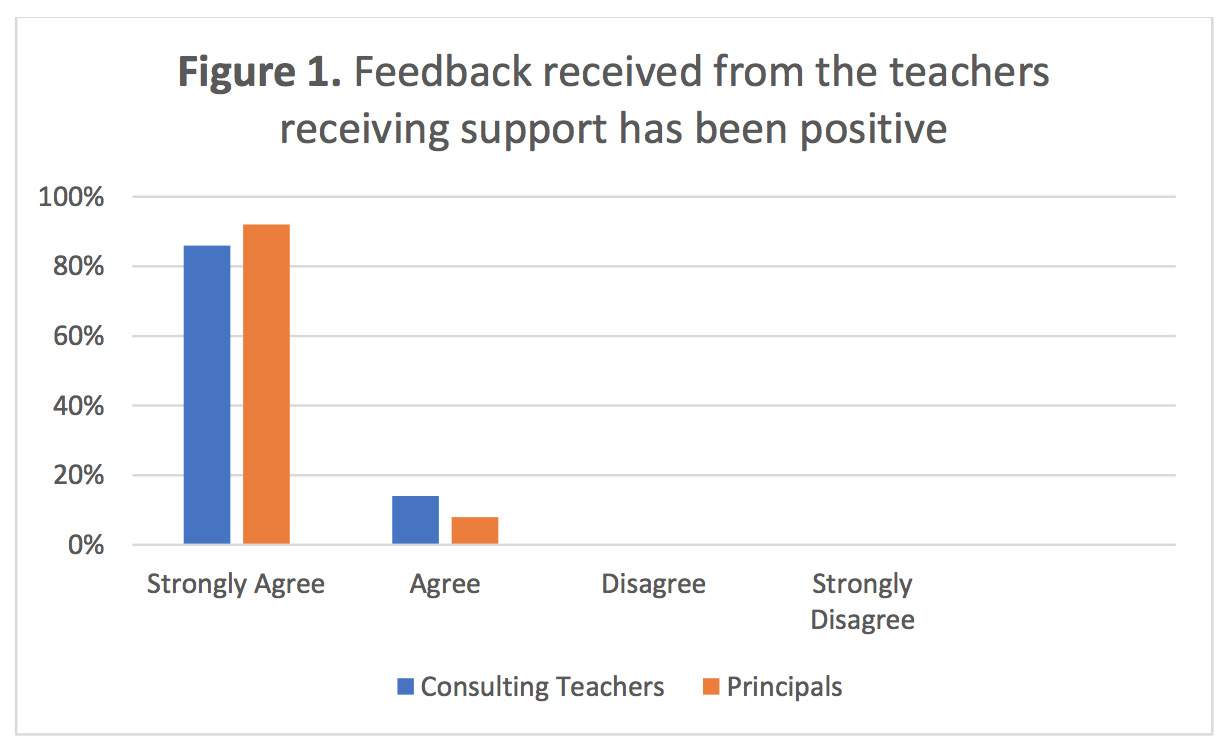
Figure 2 asked whether CTs and principals themselves believe the program is beneficial. In this case the response was unanimous and all strongly agreed that the program is beneficial.
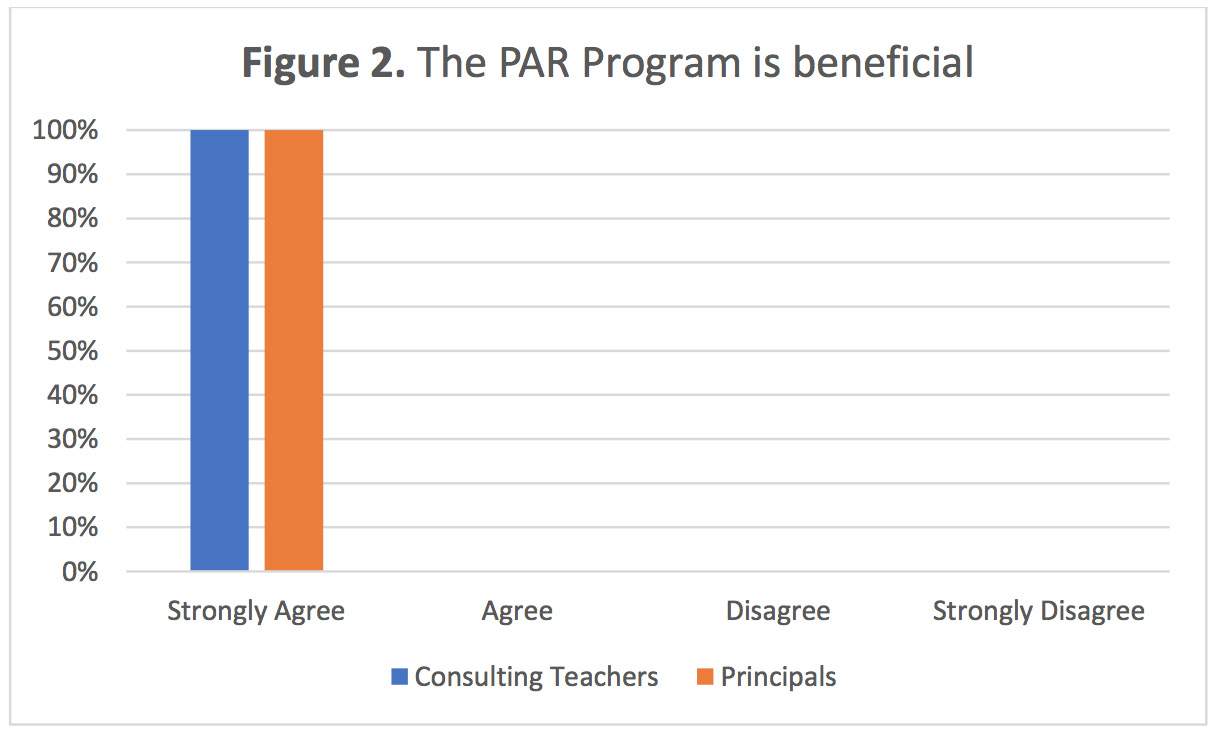
The survey also asked whether CTs and principals saw positive changes in teaching practice as a result of the supported teachers participating in the program and receiving CT support. In this case 100% of respondents, both principals and CTs, either agreed or strongly agreed that they saw positive changes in teaching practice take place as a result of the district’s PSP program (see Figure 3).
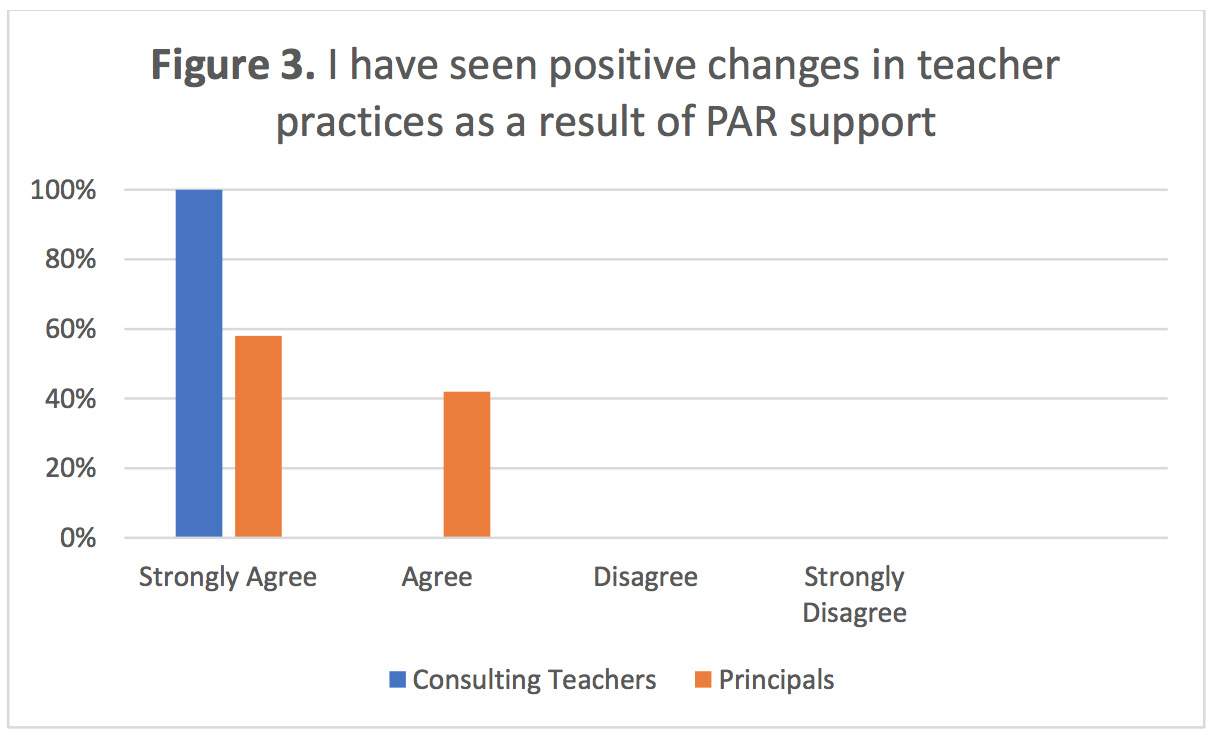
Not only were CTs making meaningful connections that principals agree positively impacted new teacher practice, but they were also providing them with intensive, one on one coaching which CTs report as having had a significant impact on new teacher retention over the course of the school year. In fact, CTs indicated that by mid school year not a single new teacher served by the program had quit their teaching position.
Additional data on the program’s effectiveness was also gathered through focus groups of the teachers who received support through the program (supported teachers). APA conducted focus groups with 14 out of the 88 first year supported teachers. Teachers in these focus groups unanimously supported the program and expressed a high degree of satisfaction with the level and types of support received from their CT. These new teachers especially valued what they described as the opportunity to develop personalized, unique relationships and coaching experiences with their CTs.
In addition, APA received survey data from one third of the 88 supported teachers. As seen in figure 4, the supported teachers who responded to APA’s survey nearly unanimously agreed that their CTs had improved the quality of their instruction.
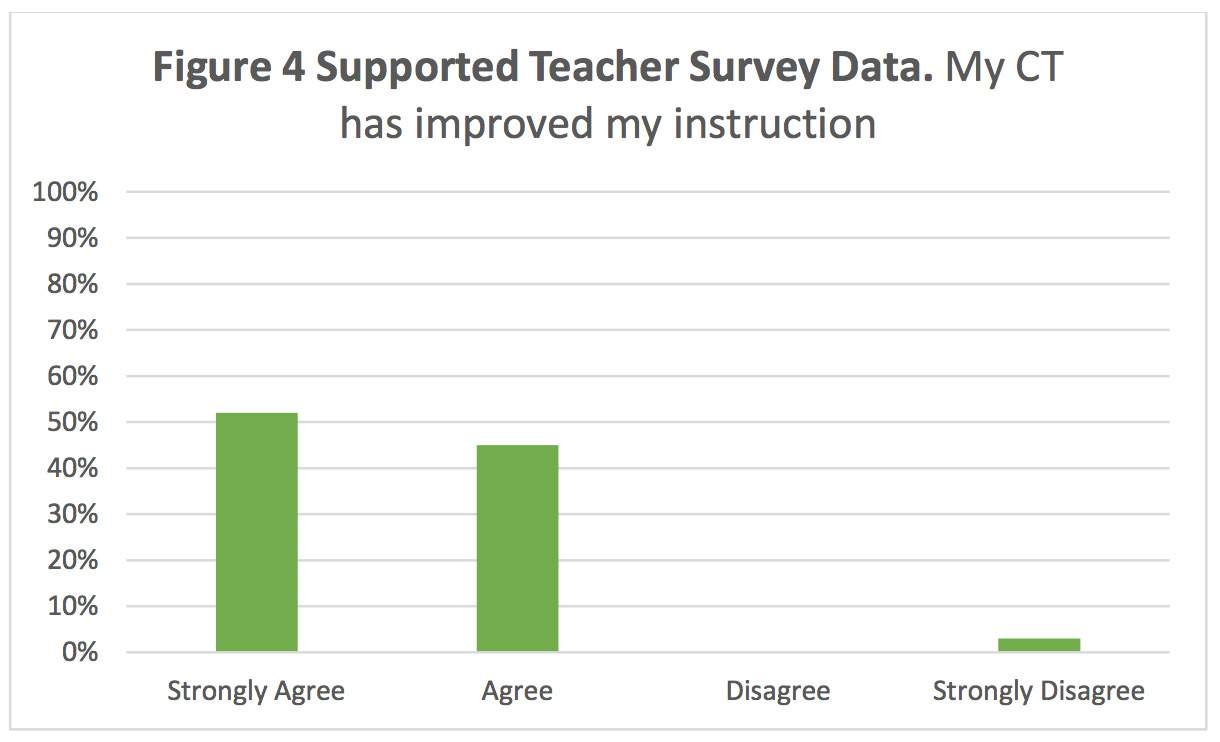
Survey data also indicated that the support provided was intensive. About 52% of new teacher survey respondents reported having weekly CT visits, whereas 45% saw their CT every other week or once a month. In addition, 68% of the teachers surveyed said that their visits with CTs lasted between 30-60 minutes.
There are also positive signs in the survey data that the PSP may be helping to make inroads in addressing the district’s key challenge regarding the turnover of new teachers. In fact, as seen in Figure 5 below, 87% of supported teachers responding to the survey agreed or strongly agreed with the statement that the program “has made it more likely for them to remain teaching in the district.†Out of the 88 supported teachers, 75 teachers have told SAISD they will return for the 2017-2018 school year. This is a retention rate of 85%. This indicates the PSP is having a strong effect on keeping teachers in the district.
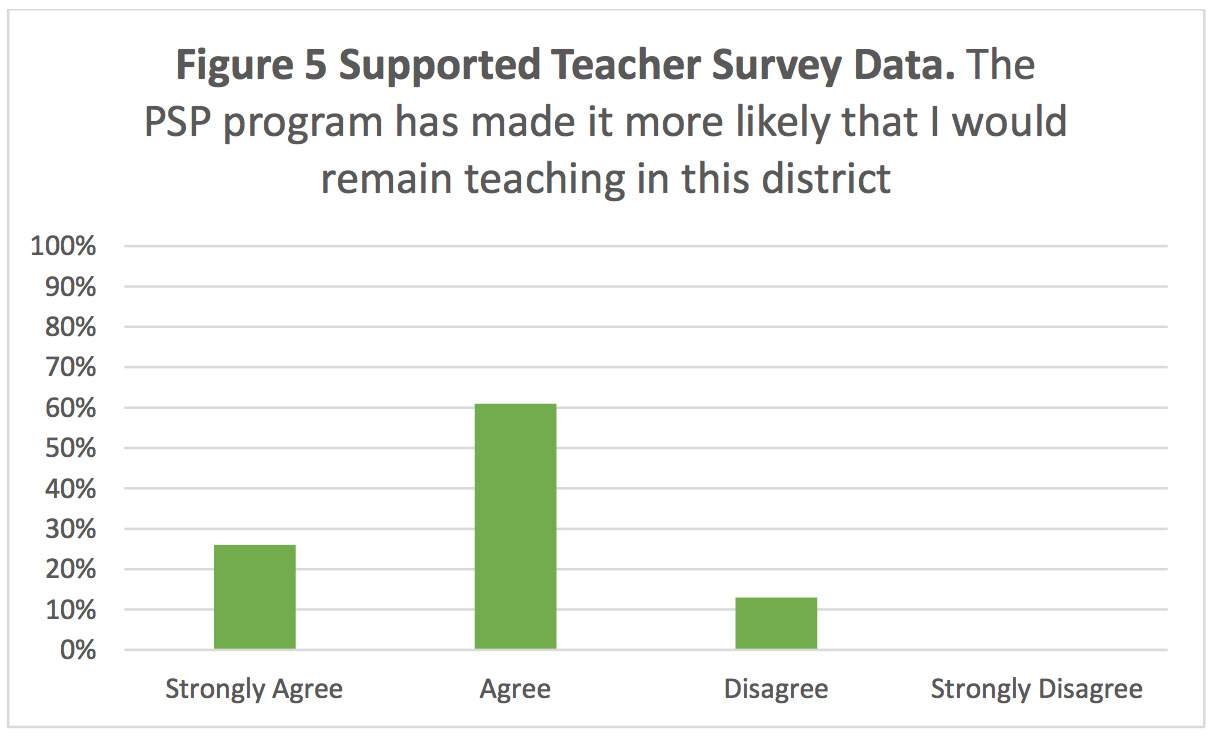
Additionally, as seen in Figure 6, almost all (97%) of the supported teachers agreed or strongly agreed that the program made them feel supported by the district and that this support increased their belief that the district wants them to be successful. In this way, the PSP is helping to promote teacher retention within SAISD while providing a highly valued source of support for first year teachers.
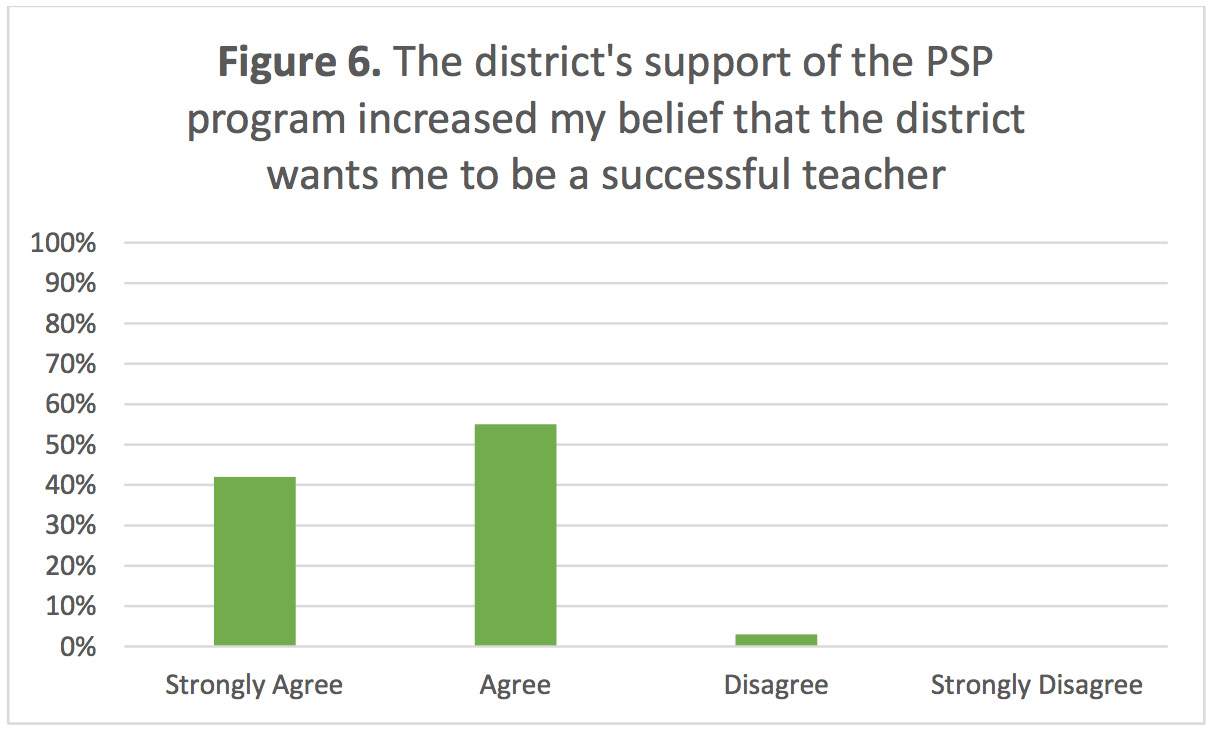
Interestingly, new teachers participating in APA’s focus groups indicated that their colleagues in many other districts did not receive similar support during their first year of instruction. The SAISD teachers stated that these new teacher colleagues in other districts have indicated that, had they known about the opportunity to receive such support in SAISD, it may have influenced their decision to pursue a teaching job in SAISD. This feedback represents a potential future recruiting benefit to SAISD that may be worth tracking and studying over the next several years.
Conclusion
By bringing together both administrators and labor leaders, PSP offers a strong example of impactful work being created through SW TURN. The PSP program was able to provide valuable support to first year teachers, which in turn may increase retention rates of new teachers within the district. Through the implementation of this program, both the district and the union demonstrated a considerable resource investment towards first year teachers.
Although it is only in its pilot year, the PSP program has been reported as a stunning collaborative success at all levels, by all parties involved: district leaders, union leaders, principals, consulting teachers, and the first year teachers who are the target of the support. The program also stands as a major success story for SW TURN, and helps demonstrate that, when labor and district leaders come together with common goals, they can collaboratively implement effective policy changes. Through this collaboration, the PSP has begun to transform how first year teachers receive support in SAISD. Additional research in future years may help shed further light on the impacts of this support on new teacher retention over time, on student performance, and on the working relationship between district and teacher union leaders.




